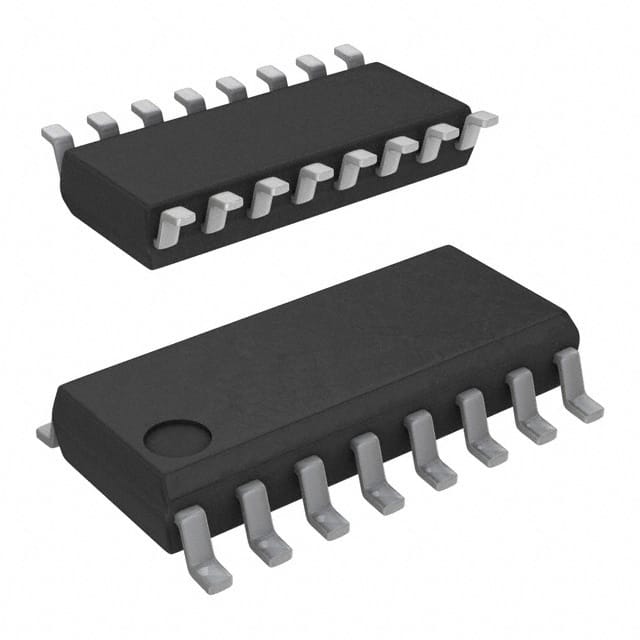Xem thông số kỹ thuật để biết chi tiết sản phẩm.

CD4051BMG4
Product Overview
- Category: Integrated Circuit (IC)
- Use: Analog Multiplexer/Demultiplexer
- Characteristics: High-speed, low-power consumption, wide voltage range
- Package: SOIC (Small Outline Integrated Circuit)
- Essence: CMOS analog multiplexer/demultiplexer
- Packaging/Quantity: Tape and Reel, 2500 units per reel
Specifications
- Number of Channels: 8
- Supply Voltage Range: 3V to 18V
- On-Resistance: 125Ω (typical)
- Operating Temperature Range: -55°C to +125°C
- Input Signal Range: 0V to VDD
- Propagation Delay Time: 180ns (typical)
Detailed Pin Configuration
The CD4051BMG4 has a total of 16 pins. The pin configuration is as follows:
- A0: Address Input
- A1: Address Input
- A2: Address Input
- E: Enable Input
- Z: Common Output/Input
- Y0: Channel 0 Output/Input
- Y1: Channel 1 Output/Input
- Y2: Channel 2 Output/Input
- GND: Ground
- Y3: Channel 3 Output/Input
- Y4: Channel 4 Output/Input
- Y5: Channel 5 Output/Input
- VDD: Supply Voltage
- Y6: Channel 6 Output/Input
- Y7: Channel 7 Output/Input
- VEE: Negative Supply Voltage
Functional Features
- Wide voltage range allows compatibility with various systems
- Low power consumption makes it suitable for battery-powered devices
- High-speed operation enables efficient signal switching
- CMOS technology ensures low static power dissipation
Advantages and Disadvantages
Advantages
- Versatile multiplexer/demultiplexer for analog signals
- Easy to use with straightforward pin configuration
- Wide supply voltage range enhances flexibility
- Low power consumption extends battery life
- High-speed operation enables real-time signal processing
Disadvantages
- Limited number of channels (8)
- Propagation delay may affect time-sensitive applications
- Not suitable for high-frequency applications
Working Principles
The CD4051BMG4 is a CMOS analog multiplexer/demultiplexer. It uses address inputs (A0, A1, A2) to select one of the eight channels (Y0-Y7) for routing the analog signal between the common terminal (Z) and the selected channel. The enable input (E) controls the operation of the IC.
Detailed Application Field Plans
The CD4051BMG4 finds applications in various fields, including:
- Audio Systems: Multiplexing audio signals for mixing or routing purposes.
- Instrumentation: Selecting different sensors or signal sources for measurement.
- Communication Systems: Switching between different communication channels.
- Industrial Control: Routing analog control signals in automation systems.
- Test and Measurement: Channel selection for data acquisition and analysis.
Detailed and Complete Alternative Models
- CD4051B: Similar specifications and pin configuration, but available in DIP package.
- CD4052BMG4: Dual 4-channel analog multiplexer/demultiplexer.
- CD4053BMG4: Triple 2-channel analog multiplexer/demultiplexer.
- CD4067BMG4: 16-channel analog multiplexer/demultiplexer.
These alternative models offer similar functionality with varying channel counts and package options.
Word count: 410 words
Liệt kê 10 câu hỏi và câu trả lời thường gặp liên quan đến ứng dụng CD4051BMG4 trong giải pháp kỹ thuật
Sure! Here are 10 common questions and answers related to the application of CD4051BMG4 in technical solutions:
Q1: What is CD4051BMG4? A1: CD4051BMG4 is a multiplexer/demultiplexer integrated circuit (IC) that allows multiple analog or digital signals to be routed through a single channel.
Q2: What is the purpose of CD4051BMG4? A2: The purpose of CD4051BMG4 is to enable the selection and routing of multiple input signals to a single output, or vice versa, based on control signals.
Q3: How many channels does CD4051BMG4 have? A3: CD4051BMG4 has 8 channels, which means it can handle up to 8 different input/output signals.
Q4: Can CD4051BMG4 handle both analog and digital signals? A4: Yes, CD4051BMG4 is designed to handle both analog and digital signals, making it versatile for various applications.
Q5: What is the voltage range supported by CD4051BMG4? A5: CD4051BMG4 supports a wide voltage range from -5V to +20V, making it suitable for many different voltage levels.
Q6: How is CD4051BMG4 controlled? A6: CD4051BMG4 is controlled using three control pins (A, B, and C), which determine the channel selection.
Q7: Can CD4051BMG4 be cascaded to increase the number of channels? A7: Yes, CD4051BMG4 can be cascaded together to increase the number of channels. By connecting the output of one IC to the input of another, you can expand the number of selectable channels.
Q8: What are some common applications of CD4051BMG4? A8: CD4051BMG4 is commonly used in audio/video signal routing, analog-to-digital conversion, data acquisition systems, multiplexing/demultiplexing of sensors, and many other applications that require signal selection.
Q9: Can CD4051BMG4 handle high-frequency signals? A9: CD4051BMG4 has a limited bandwidth, typically around 10 MHz, so it may not be suitable for very high-frequency signals. It is more commonly used for lower frequency applications.
Q10: Is CD4051BMG4 available in different package types? A10: Yes, CD4051BMG4 is available in various package types, including DIP (Dual Inline Package) and SOIC (Small Outline Integrated Circuit), making it compatible with different circuit board designs and assembly methods.
Please note that these answers are general and may vary depending on specific datasheet specifications and application requirements.

